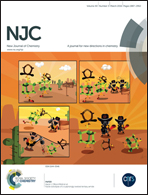Synthesis, X-ray crystal structure, DNA/protein binding and DNA cleavage studies of novel copper(ii) complexes of N-substituted isatin thiosemicarbazone ligands†
Abstract
A new series of N-substituted isatin thiosemicarbazone ligands (L1–L5) and their copper(II) complexes [Cu(II)(ITSC)] (1–5) were synthesized and characterized by elemental analyses, UV-Visible, FT-IR, 1H and 13C NMR/EPR and mass spectroscopic techniques. The molecular structures of L1–L5, and 3 were confirmed by single crystal X-ray crystallography. The X-ray diffraction studies of the complexes revealed a square planar geometry. The interaction of calf thymus (CT) DNA and bovine serum albumin (BSA) with the copper(II) complexes was explored using absorption and emission spectral methods. Spectral evidence showed the intercalative mode of DNA binding with the copper(II) complexes. The DNA cleavage study showed that the complexes cleaved DNA without any external agents. Spectral evidence also supported the binding property of the complexes with the protein. The alterations in the secondary structure of the protein by the copper(II) complexes (1–5) were confirmed by synchronous and three-dimensional fluorescence spectroscopic studies.


 Please wait while we load your content...
Please wait while we load your content...